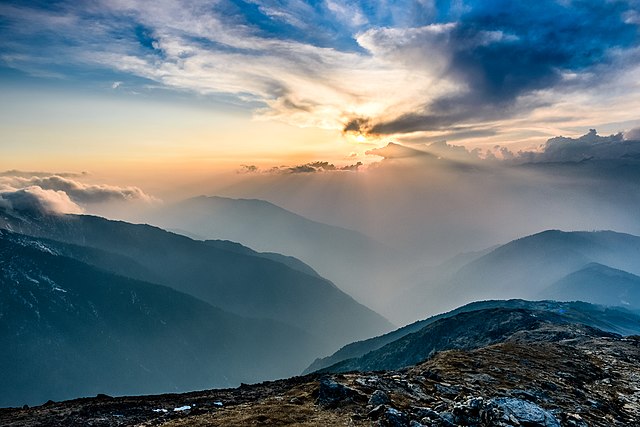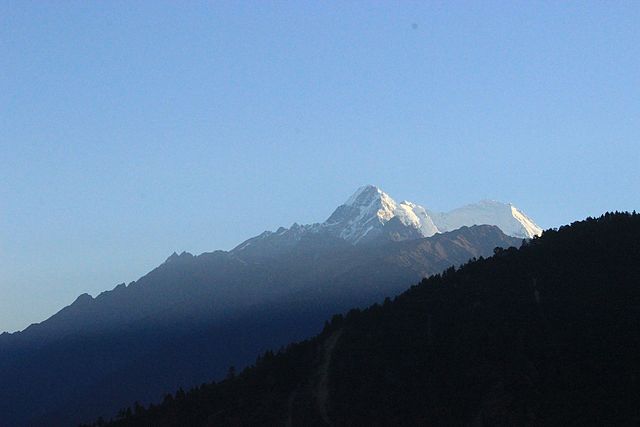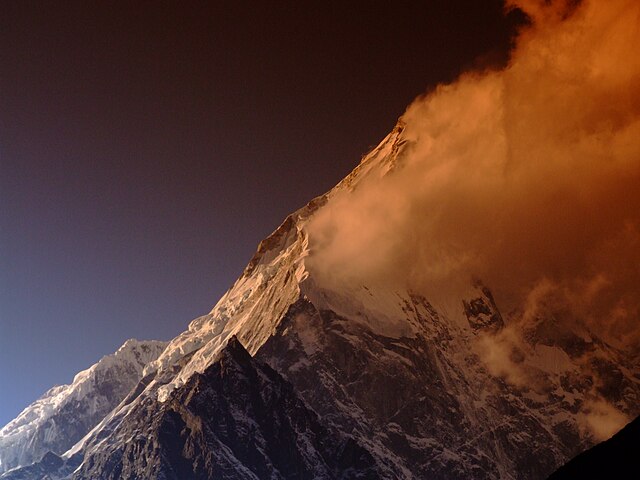Langtang-Nationalpark (लाङटाङ राष्ट्रिय निकुञ्ज)
Der Langtang-Nationalpark befindet sich im Norden der nepalesischen Verwaltungszone Bagmati, etwa 50 km nördlich der Hauptstadt Kathmandu.
Der 1976 gegründete Langtang-Nationalpark umfasst ein 1710 km² großes Gebiet im Zentral-Himalaya.
Der Nationalpark erstreckt sich über Teile folgender Distrikte: Nuwakot, Rasuwa und Sindhupalchok. Im Norden grenzt der Nationalpark an das Autonome Gebiet Tibet der Volksrepublik China.
Im Schutzgebiet befindet sich das Flusstal des Langtang Khola sowie die angrenzenden Gebirgszüge. Im Norden erstreckt sich im Himalaya-Hauptkamm das Langtang Himal-Massiv mit dem 7227 m hohen Langtang Lirung. Weitere Gipfel im Langtang Himal sind Kimshung, Dragmarpo Ri und Yala Peak.
In der niedrigeren südlichen Bergkette befinden sich unter anderen folgende Gipfel: Dorje Lhakpa (6966 m) und Naya Kanga (5846 m). An deren Südhang entspringen die Flüsse Melamchi Khola, Indrawati und Balephi Khola. Im Nordwesten dieser Bergkette liegt der als Heiligtum verehrte Bergsee Gosainkunda. Unterhalb diesem liegt ein weiterer Bergsee, der Bhairabkunda. Im Osten des Nationalparks verläuft entlang der chinesischen Grenze eine weitere Bergkette in Nord-Süd-Richtung, die dem Jugal Himal zugerechnet wird. Zu dieser gehört auch der markante 6427 m hohe Langshisha Ri.
- 1 Tourismus
- 2 Weblinks
- 3 Einzelnachweise
Links
Images Gallery
-

-
-
 Siedlung Langtang
Siedlung Langtang
-
-

-

-

-

-

-

-

-

-

-

-

-

-

-

Comments
-
First trekking of my life😍😍 it was simply amazing. You will see 360° view of mountains. Langtang Valley is amazing. Kyanjin Gompa is the last place with hotels. Local people are so helpful. You get fresh n good Nepalese food. Blue sky, clean water of Langtang river👌👌You are going to love it. Don't carry much luggage, food is available. You may carry high calorie but low weight foods such as energy bar, dry fruits and ORS is the most needed thing. You can't compromise with the quality of shoes. Knee cap and trekking stick provide you great support
a month ago -
-
Best trekking route and best tourism destination in Nepal . Rich with flora and fauna. Great view of mountains and friendly local people. Nepal's first Himalaya national park and it was established in 1976. This national park is a great place to visit where you would enjoy with beautiful view of rivers, forest, landscape, animals, birds and different faces of people and their culture. "Naturally Nepal- Once is not enough". Rare animal Red panda and other hilly wildlife is found here.
6 months ago -
I do have best experience of my life, the worm hospitality still exists here. This treeking was lifetime experience and memorable
3 months ago -
Really cool place and some parts are accessible to vehicles too. Road is mostly good till Ramche.
2 months ago -
-
It was established in 1976 to conserve the unique flora and fauna of the region. It is the nearest national park of the capital Kathmandu in the Central Himalayan Region. The 1710 sq. km. of the park extends over parts of Nuwakot, Rasuwa, and Sindhupalchok districts in the southern mountainous terrain of the Nepal-China (Tibet) border. In 1998 an areas of 420 sq. km in and around the park declare as a buffer zone. The park represents a meeting point between indo-Malayan and Palearctic realms, and holds a rich biodiversity. Buffer zone management is a joint venture between the park office and the local communities. Local communities have a decision-making role in the management of such areas. Additionally, the local communities or the BZ receive 30 to 50 % of the park revenue for the better management of natural resources to ensure a sustainable supply of resources and community development Climate: September through May offers a variety of natural splendors, from lush temperate river valleys with screeching langur to spectacular old growth forest and glacial-craved cliffs rimmed by snow-covered peaks. The weather is also relatively dry except January-February when one may come across snow.Autumn is the best time to visit the Park. By April bursts of red, pink, and while rhododendrons stretch into towering canopies of fir and oak forests. Advent of warm weather makes the Yak and Chauri herds ascend to higher elevation, making occasional camps in the pasturelands, to follow years of tradition. From June to august, skies are heavy with monsoon rains. During August, a lively festival at Gosaikunda Lake attracts thousands of Hindu pilgrims and September witnesses’ spectacular display of wild flowers, while livestock herds, once again, return to lower pastures. #ontopofamountain #yoga #meditation #camp
4 months ago -

















